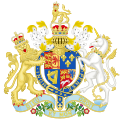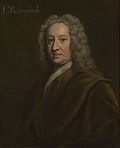Secretary of State for the Southern Department
Former British political position From Wikipedia, the free encyclopedia
The Secretary of State for the Southern Department[1] was a position in the cabinet of the government of the Kingdom of Great Britain up to 1782, when the Southern Department became the Home Office.[2][3]
| Great Britain Secretary of State for the Southern Department | |
|---|---|
 Coat of Arms of the Kingdom of Great Britain Government | |
| The Southern Department | |
| Style | The Right Honourable (Formal prefix) |
| Member of | British Cabinet |
| Seat | Westminster, London |
| Appointer | The British Monarch on advice of the Prime Minister |
| Term length | No fixed term |
| Formation | 1660-1782 |
| First holder | Edward Nicholas |
| Final holder | Wills Hill, 1st Earl of Hillsborough |
History
Summarize
Perspective
Before 1782, the responsibilities of the two British Secretaries of State for the Northern and the Southern departments were divided not based on the principles of modern ministerial divisions, but geographically. The Secretary of State for the Southern Department was responsible for Ireland, the Channel Islands, France, Spain, Portugal, the Old Swiss Confederacy, the states of Italy, and the Ottoman Empire. He was also responsible for the American colonies until 1768, when the charge was given to the Secretary of State for the Colonies. The Secretary of State for the Northern Department was responsible for relations with the Dutch Republic, Scandinavia, Poland, Russia, and the Holy Roman Empire. Domestic responsibilities in England and Wales were shared between the two Secretaries. After the union with Scotland in 1707, the two secretaries also took responsibility for Scotland when there was no Secretary of State for Scotland in office.[4]
Until 1706, the practice was generally for the senior official to lead the Southern Department, and the junior the Northern Department, with the Northern Secretary being transferred to the Southern Department when a vacancy arose at the latter.[4] During the reigns of George I and George II, however, the Northern Department began to be seen as the more important, since its responsibilities included the monarchs' ancestral home of Hanover.[5] During the reign of George III, the two departments were of approximately equal importance.[6]
In 1782, the two Secretaries of State were reformed as the Secretary of State for the Home Department and the Secretary of State for Foreign Affairs.[7]
List of Southern Secretaries
| Portrait | Name (Birth–Death) |
Term of office | Monarch (Reign) |
Ref. | |
|---|---|---|---|---|---|
 |
Sir Edward Nicholas (1593–1669) |
1 June 1660 |
20 October 1662 |
Charles II (1660–1685) |
[10] |
 |
Henry Bennet 1st Earl of Arlington (1618–1685) [a] |
20 October 1662 |
11 September 1674 |
[11] | |
 |
Henry Coventry MP for Droitwich (c. 1618–1686) |
11 September 1674 |
26 April 1680 |
[12] | |
 |
Robert Spencer 2nd Earl of Sunderland (1641–1702) |
26 April 1680 |
2 February 1681 |
||
 |
Sir Leoline Jenkins MP for Oxford University (c. 1625–1685) |
2 February 1681 |
14 April 1684 |
[13] | |
 |
Robert Spencer 2nd Earl of Sunderland (1641–1702) |
14 April 1684 |
28 October 1688 |
||
James II (1685–1688) | |||||
 |
Charles Middleton 2nd Earl of Middleton (c. 1650–1719) |
28 October 1688 |
2 December 1688 |
[14] | |
 |
Charles Talbot 12th Earl of Shrewsbury (1660–1718) |
14 February 1689 |
2 June 1690 |
Mary II (1689–1694) & William III  (1689–1702) |
|
 |
Daniel Finch 2nd Earl of Nottingham (1647–1730) [b] |
2 June 1690 |
November 1693 |
[15] | |
 |
Sir John Trenchard MP for Poole (1649–1695)[c] |
November 1693 |
27 April 1695 |
[16] | |
 |
Charles Talbot 1st Duke of Shrewsbury (1660–1718) |
27 April 1695 |
12 December 1698 |
||
 |
James Vernon MP for Westminster (1646–1727) [d] |
12 December 1698 |
14 May 1699 |
[17] | |
 |
Edward Villiers 1st Earl of Jersey (c. 1656–1711) |
14 May 1699 |
27 June 1700 |
||
 |
James Vernon MP for Westminster (1646–1727) [e] |
27 June 1700 |
4 January 1702 |
[17] | |
 |
Charles Montagu 4th Earl of Manchester (c. 1662–1722) |
4 January 1702 |
1 May 1702 |
||
Anne (1702–1714) | |||||
 |
Daniel Finch 2nd Earl of Nottingham (1647–1730) |
2 May 1702 |
22 April 1704 |
[15] | |
 |
Sir Charles Hedges MP for West Looe (1650–1714) [f] |
18 May 1704 |
3 December 1706 |
[18] | |
 |
Charles Spencer 3rd Earl of Sunderland (1675–1722) |
3 December 1706 |
13 June 1710 |
[19] | |
 |
William Legge 1st Earl of Dartmouth (1672–1750) |
15 June 1710 |
6 August 1713 |
||
 |
Henry St John 1st Viscount Bolingbroke (1678–1751) |
17 August 1713 |
31 August 1714 |
[20] | |
George I (1714–1727) | |||||
 |
James Stanhope MP for Cockermouth (1673–1721) [g] |
27 September 1714 |
22 June 1716 |
[21] | |
 |
Sir Paul Methuen MP for Brackley (c. 1672–1757) [h] |
22 June 1716 |
10 April 1717 |
[22] | |
 |
Joseph Addison MP for Malmesbury (1672–1719) |
12 April 1717 |
14 March 1718 |
[23] | |
 |
James Craggs 'the Younger' MP for Tregony (1686–1721) |
16 March 1718 |
16 February 1721 |
[24] | |
 |
John Carteret 2nd Baron Carteret (1690–1763) |
4 March 1721 |
31 March 1724 |
||
 |
Thomas Pelham-Holles 1st Duke of Newcastle (1693–1768) [i] |
6 April 1724 |
12 February 1748 |
||
George II (1727–1760) | |||||
 |
John Russell 4th Duke of Bedford (1710–1771) |
12 February 1748 |
13 June 1751 |
||
 |
Robert Darcy 4th Earl of Holdernesse (1718–1778) |
18 June 1751 |
23 March 1754 |
||
 |
Sir Thomas Robinson MP for Christchurch (1695–1770) |
24 March 1754 |
October 1755 |
[25] | |
 |
Henry Fox MP for Windsor (1705–1774) |
14 November 1755 |
13 November 1756 |
[26] | |
 |
William Pitt 'the Elder' MP for Okehampton (1708–1778) |
4 December 1756 |
6 April 1757 |
[27] | |
 |
Robert Darcy 4th Earl of Holdernesse (1718–1778) [j] |
6 April 1757 |
27 June 1757 |
||
 |
William Pitt 'the Elder' MP for Bath (1708–1778) |
27 June 1757 |
5 October 1761 |
[27] | |
George III (1760–1820) | |||||
 |
Charles Wyndham 2nd Earl of Egremont (1710–1763) |
9 October 1761 |
21 August 1763 |
[28] | |
 |
George Montagu-Dunk 2nd Earl of Halifax (1716–1771) |
9 September 1763 |
10 July 1765 |
||
 |
Henry Seymour Conway MP for Thetford (1719–1795) |
12 July 1765 |
23 May 1766 |
[29] | |
 |
Charles Lennox 3rd Duke of Richmond (1735–1806) |
23 May 1766 |
29 July 1766 |
||
 |
William Petty 2nd Earl of Shelburne (1737–1805) |
30 July 1766 |
20 October 1768 |
[30] | |
 |
Thomas Thynne 3rd Viscount Weymouth (1734–1796) |
21 October 1768 |
12 December 1770 |
||
 |
William de Zuylestein 4th Earl of Rochford (1717–1781) |
19 December 1770 |
9 November 1775 |
||
 |
Thomas Thynne 3rd Viscount Weymouth (1734–1796) [k] |
9 November 1775 |
November 1779 |
||
 |
Wills Hill 1st Earl of Hillsborough (1718–1793) |
25 November 1779 |
27 March 1782 |
[31] | |
See also
Notes
- Returned as MP for Callington from 1661 to 1665; thereafter raised to the peerage of England as Baron Arlington, and created Earl of Arlington in 1672.
- Returned as MP for Wendover from March 1715 to 1715; thereafter returned as MP for Cockermouth from 1715 to 1717.
- In February 1746 John Carteret, 2nd Earl Granville held office for two days, however as the formalities of his appointment were not completed sources typically do not include him as a Southern Secretary.
Citations
Wikiwand - on
Seamless Wikipedia browsing. On steroids.
